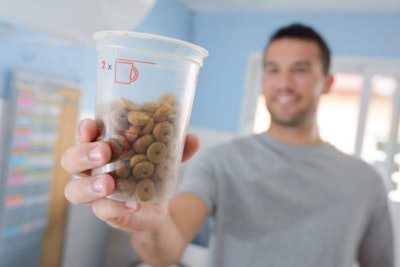
In the BBC article “The hidden reason processed pet foods are so addictive,” the reporter wrote that two chemicals found in rotting flesh are used as palatants in pet foods. However, dog and cat food ingredient suppliers refute this. Enhancing transparency and media relations could help dog and cat food ingredient providers avoid similar media situations in the future.
The BBC reporter quoted an emeritus New York University professor who said that many animals we keep as pets naturally eat feces and other items humans find disgusting. As such, pet food companies face a challenge in creating pet foods foul enough to attract a dog or cat, but not so disgusting that pet owners will reject it.
This echoes what Kadri Koppel, Ph.D., professor at Kansas State University, said at Petfood Forum 2017. Pet food characteristics, pets’ reactions and owners’ observations make up a triangle of influences on whether a pet food succeeds in the market, she said. Smell, texture, taste and other sensations can determine if dogs and cats accept or reject a pet food. Similarly, the sensory characteristics of the pet food and its packaging influence pet owners’ perception of the food.
Some characteristics that pets may love can disgust their owners. For example, while dogs may be attracted to pungent odors, owners may be unwilling to tolerate that stink in their homes, Koppel said. This palatant Catch-22 means many pet foods smell less intensely than would be ideal to entice dogs or cat, hence lower levels of palatant chemicals often appear on pet foods than could hypothetically be used to most attract the animals.
Claims of corpse chemicals in pet food
In the BBC article, the reporter moves from this palatant paradox to write that these compounds include putrescine and cadaverine. Bacteria produce putrescine and cadaverine as the microbes devour amino acids in putrefied cadavers, spoiled meat or other decaying proteins, according to the American Chemical Society.
“They're largely responsible for the revolting smell of rotting flesh – and cats love them,” the BBC reporter wrote. “While in human food, their levels are sometimes closely monitored as a way of ensuring the freshness and safety of meat, they're often actively added to cat and dog food, either as offal extracts or lab-made additives.”
The R&D director at a global supplier of pet food palatants refuted this.
“Pet food manufacturers do not add putrescine and cadaverine to improve palatability,” the source, who wished to remain anonymous, told Petfood Industry. “Putrescine and cadaverine are biogenic amines and by-products of microbial metabolism. They are part of the natural degradation of proteins.”
Another pet food ingredient company responded similarly.
“At Diana Pet Food, we do not intentionally add biogenic amines to our product to make them palatable,” Cécile Saint-Paul, marketing, research and development director at Diana Pet Food wrote in an email
Putrescine and cadaverine potentially could be found in low-quality chicken or pork fat, which subsequently may make their way into equally low-end pet foods, Ryan Yamka, Ph.D., founder of Luna Science and Nutrition and founder of Guardian Pet Food Co., wrote in an email. However, formulators do not intentionally add them. Instead, palatants typically contain viscera or liver that is hydrolyzed in the presence of enzymes, sugars and other amino acids.
As opposed to adding putrescine and cadaverine, researchers have developed means to measure pet food spoilage using the presence of putrescine, cadaverine, spermine, spermidine, tyramine and similar compounds. They published their results in the Journal of Separation Science. All of these biogenic amines have potentially toxic effects in dogs and cats, though both animals may have inherited some degree of tolerance for the chemicals from their wild and feral ancestors, according to Kemin Nutrisurance.
“There is a shortage of literature evaluating the precise effect of biogenic amines on dogs and cats due to ethical reasons,” Kemin representatives wrote on their website. “However, studies have shown elevated levels of biogenic amines can cause food poisoning and detrimental effects on palatability and nutrition. Pet food manufacturers should control biogenic amine formation in raw materials and finished products to avoid detrimental effects to the food or pet consuming it.”
Pet food ingredient supplier media relations
Biogenic amines can hurt pets in high doses, regardless of wolf and wild cat genes. Likewise, believing that pet food contains these chemicals may harm consumer sentiment. The BBC article may have shaped public opinion about palatants. Pet owners likely don’t want chemicals associated with rotting corpses in their dog and cat food. Palatants receive little business-to-consumer media coverage, giving the BBC story added importance. As pet owners increasingly scrutinize ingredients, topics like palatability may appear in mainstream news coverage more frequently.
The BBC reaches a wide audience of pet owners both in the United Kingdom and around the world. On the other hand, this business-to-business media article will not reach many pet owners. The audience for Petfood Industry is intentionally limited to those working in businesses producing, distributing or marketing companion animal foods and treats. To educate consumers, industry professionals can head off concerns by making their companies more transparent, while monitoring media coverage of pet food. Similarly, unlike Petfood Industry’s reporter and editors, most journalists can’t devote all their time to companion animals, so they need ready sources of empirical information from pet food ingredient suppliers. Proactively reaching out to media helps pet food industry professionals develop amicable relationships with journalists.
Petfood Forum
Pet food customer demands now follow human food demands, changing which ingredients dog and cat food manufacturers purchase. Pet food ingredient commodity buyers can learn what these future demands might be at Petfood Forum.
Register for Petfood Forum
Petfood Forum brings together pet food professionals from around the world to network, exchange ideas and move business forward with one another and with the industry's leading pet food manufacturers and suppliers.
The in-person and on-demand event delivers the opportunity to learn about pet nutrition and ingredients, global pet food market growth, pet food safety, processing, packaging and more, all from leading, recognized pet food industry experts.
















